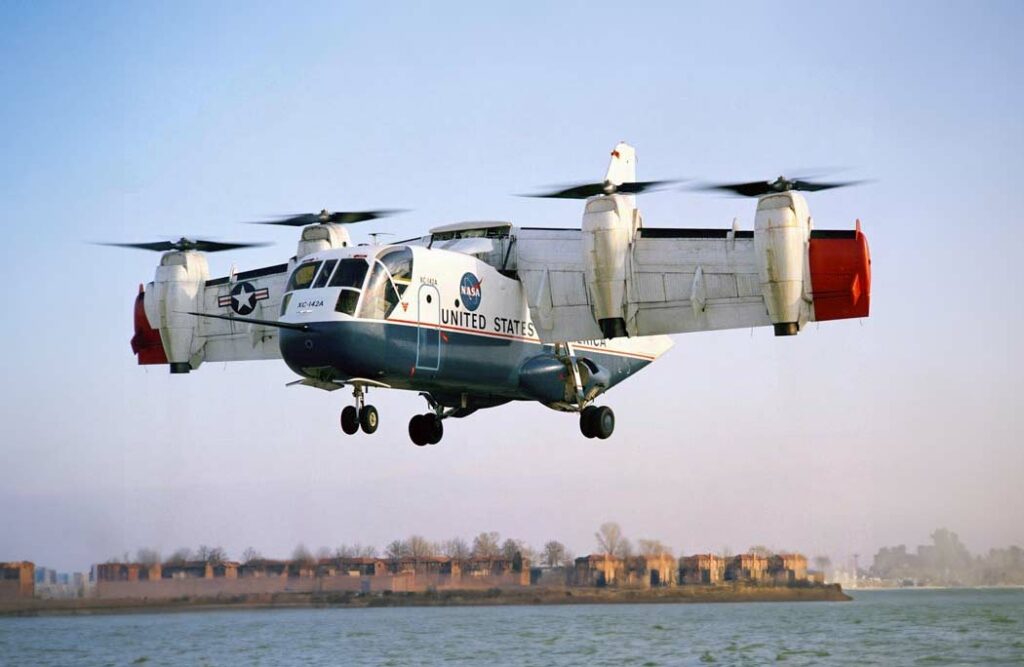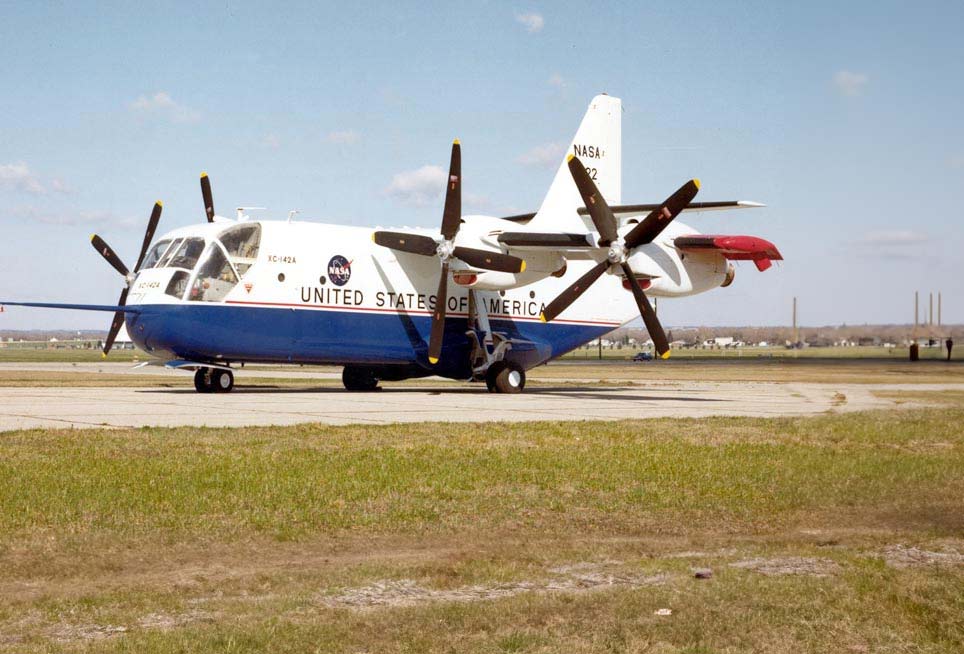The LTV XC-142 is a tiltwing, experimental V/STOL aircraft developed in the 1960s for multi-service utility.
In brief
The LTV XC-142 was an innovative tiltwing, experimental aircraft designed for vertical/short takeoff and landing (V/STOL) capabilities, aimed at enhancing the operational flexibility of the U.S. military. Developed in the mid-1960s, it featured a unique design allowing its wings to tilt from a horizontal to a vertical position, enabling it to take off, land, and hover like a helicopter while cruising like a conventional airplane. Equipped with four turboprop engines, the XC-142 demonstrated considerable cargo capacity, high speed, and long-range potential, distinguishing itself in various test roles but was ultimately not adopted for mass production due to various challenges encountered during its development and testing phases.

The LTV XC-142 represents a bold foray into the realm of vertical/short takeoff and landing (V/STOL) aircraft during a period marked by rapid technological advancements and evolving military requirements. This experimental aircraft was developed to explore the potential of tiltwing technology in providing flexible, efficient, and fast troop and cargo transportation.
History of the Development of the LTV XC-142
The development of the LTV XC-142 was set against the backdrop of the 1960s, an era characterized by intense innovation in aviation technology, driven by both the Cold War’s demands and the space race’s inspirations. The U.S. military sought a versatile V/STOL aircraft capable of fulfilling a variety of roles, from troop transport to cargo supply, especially in environments lacking conventional runway infrastructure.
The XC-142 project was initiated by a consortium led by Ling-Temco-Vought (LTV) in collaboration with Ryan Aeronautical and Hiller Aircraft, responding to the U.S. military’s requirement for a medium-lift, multi-service aircraft. The program was launched to explore the feasibility of tiltwing aircraft in performing missions traditionally requiring helicopters, but with the speed and range of fixed-wing aircraft.
The aircraft’s first flight occurred on September 29, 1964, marking the beginning of an extensive testing and evaluation phase. The XC-142 was designed to combine the vertical lift capabilities of a helicopter with the long-range, high-speed characteristics of a turboprop airplane, aiming to significantly enhance the military’s operational flexibility and responsiveness.
The development of the XC-142 was influenced by the prevailing military strategies and the need for rapid deployment capabilities. Its tiltwing design was seen as a revolutionary solution to the logistical challenges posed by conflict scenarios requiring quick and versatile transportation options. Despite the innovative design and the aircraft’s successful demonstration of its intended capabilities, the program faced various technical challenges, leading to questions about the tiltwing concept’s viability and the aircraft’s operational practicality.
The XC-142 did not receive a NATO nickname, typically assigned to operational aircraft with a significant presence in the alliance’s inventory. The experimental nature of the XC-142 and its limited production meant that it remained relatively unique, with its contributions more aligned with research and development rather than active service deployment.
Design of the LTV XC-142
The LTV XC-142’s design was groundbreaking, featuring a tiltwing mechanism that allowed the aircraft to transition between vertical and horizontal flight modes. This capability was central to its V/STOL functionality, enabling it to operate in environments inaccessible to conventional aircraft. The airframe was constructed to accommodate this dual-mode operation, with robust mechanisms to pivot the wings and withstand the aerodynamic stresses encountered during transition phases.
Equipped with four General Electric T64 turboprop engines, the XC-142 was designed for power and versatility. The engines were mounted on the wing, which could be tilted up to 100 degrees, allowing for vertical takeoff, landing, and hover capabilities. The propellers were interconnected through a cross-shaft, ensuring that power would be maintained across all four propellers even if one engine failed.
The aircraft boasted a substantial cargo capacity, capable of carrying up to 32 troops or equivalent cargo. The cargo bay was designed for rapid loading and unloading, compatible with standard military pallets. The cockpit was elevated, providing excellent visibility for the pilots, crucial for both conventional flight and V/STOL operations.
However, the XC-142’s innovative design also brought challenges. The transition between vertical and horizontal flight was complex, requiring sophisticated control systems and presenting a steep learning curve for pilots. The tiltwing mechanism, while effective, added weight and mechanical complexity, impacting maintenance requirements and operational reliability. Noise and vibration levels were significant, affecting crew comfort and raising concerns about long-term endurance and operational practicality.
Despite these drawbacks, the design of the XC-142 was a significant leap forward in aviation technology, showcasing the potential for tiltwing aircraft to enhance military and civilian aviation capabilities. It demonstrated considerable advantages in terms of flexibility, payload capacity, and operational versatility, offering insights into the future possibilities of V/STOL aircraft.
Performance of the LTV XC-142
The LTV XC-142 exhibited impressive performance characteristics, particularly in its V/STOL capabilities. Powered by four 3,080 horsepower General Electric T64-GE-1 turboprop engines, the aircraft demonstrated a top speed of approximately 400 mph (640 km/h) and a range of 1,000 miles (1,600 km), with an operational ceiling exceeding 25,000 feet (7,600 meters).
Its unique tiltwing design allowed for a seamless transition between vertical and horizontal flight, providing operational flexibility unmatched by conventional aircraft. The XC-142 could carry a significant payload, up to 10,000 pounds (4,536 kg), accommodating various mission requirements, from troop transport to cargo delivery.
Comparatively, the XC-142’s performance was innovative for its time, especially considering its ability to combine the functionalities of a helicopter with the speed and range of a fixed-wing aircraft. While other V/STOL designs, like the Bell-Boeing V-22 Osprey developed later, would utilize tiltrotor technology to achieve similar operational goals, the XC-142 was among the pioneers in demonstrating the practicality and potential of such concepts, albeit with its set of challenges.
The aircraft’s operational testing highlighted its capabilities but also revealed limitations, such as mechanical complexity, maintenance intensity, and issues related to its V/STOL operations, such as downwash and noise. These factors, combined with the evolving strategic requirements and budgetary constraints, influenced the evaluation of the XC-142’s overall effectiveness and utility compared to its contemporaries and potential successors.
Variants of the LTV XC-142
The LTV XC-142 project primarily revolved around the single primary model developed and tested. Although the basic design remained consistent, the aircraft underwent various modifications throughout its testing phase to explore different configurations and improve its performance and reliability. There were no distinct variants produced for different roles or services, as the program’s focus was on validating the tiltwing concept and assessing its feasibility for broader military application.
Throughout its test program, the XC-142 was modified to address issues encountered during flight trials, such as improving stability in VTOL mode, enhancing control systems, and reducing vibration levels. These modifications were integral to understanding the aircraft’s operational capabilities and limitations, providing valuable data for future V/STOL aircraft development.

Military Use and Combat of the LTV XC-142
The LTV XC-142, primarily an experimental aircraft, was not used in combat nor officially integrated into active military service. Its role was to explore the potential of tiltwing technology for future military applications, focusing on testing and evaluation rather than operational deployment. The aircraft participated in extensive flight test programs, demonstrating its capabilities in various conditions and configurations but remained a testbed for research and development.
The XC-142’s military significance lies in its contribution to the V/STOL technology body of knowledge, influencing future designs and concepts in military aviation. While it did not see combat or enter mass production, the insights gained from its development and testing have been instrumental in advancing aircraft technology, particularly in exploring the complexities and potential of hybrid flight modes.
The aircraft was not sold to other countries, nor were any direct variants developed for foreign markets. After the testing program concluded, the XC-142 was not adopted for further military use, and the project was eventually phased out, with the aircraft retired and some units preserved in museums.
The LTV XC-142 was a pioneering aircraft that significantly contributed to the field of V/STOL technology. Despite its experimental nature and the challenges faced during its development, the aircraft showcased the possibilities and limitations of tiltwing designs. Its legacy is reflected in the subsequent development of V/STOL aircraft, providing valuable lessons that have informed the design and operation of future generations of military and civilian tiltwing and tiltrotor aircraft. The XC-142 remains a notable example of innovative engineering and ambitious vision, marking a significant chapter in the history of vertical lift aviation.
Back to the experimental aircraft section.